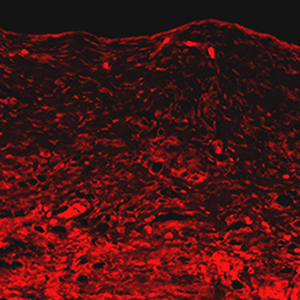Inhibition of HMGB1 suppresses inflammation and catabolism in temporomandibular joint osteoarthritis via NF-κB signaling pathway

Accepted: 24 May 2022
HTML: 12
All claims expressed in this article are solely those of the authors and do not necessarily represent those of their affiliated organizations, or those of the publisher, the editors and the reviewers. Any product that may be evaluated in this article or claim that may be made by its manufacturer is not guaranteed or endorsed by the publisher.
Authors
HMGB1 is a highly conserved nuclear protein that is rapidly released into the extracellular environment during infection or tissue damage. In osteoarthritis, HMGB1 acts as a pro-inflammatory cytokine inducing a positive feedback loop for synovial inflammation and cartilage degradation. The aim of this study was to explore the role of HMGB1 in inflammation and catabolism of temporomandibular joint osteoarthritis (TMJOA) and whether inhibition of HMGB1 affects TMJOA. Human synovial fibroblasts were incubated with HMGB1, the expression of pro-inflammatory cytokines and catabolic mediators were measured by Western blot and ELISA. NF-κB signaling pathway involvement was studied by the NF-κB inhibitor and detected by Western blotting and immunofluorescence staining. TMJOA was induced by an injection of Complete Freund’s adjuvant (CFA) into anterosuperior compartment of rat’s joint. An anti-HMGB1 antibody was used to assess the effect to HMGB1 in the synovium and cartilage of the CFA-induced TMJOA rats by H&E, Safranin O, Masson trichrome staining, immunohistochemistry and immunofluorescence. HMGB1 markedly increased the production of MMP13, ADAMTS5, IL-1β and IL-6 through activating NF-κB signaling pathway in human synovial fibroblasts. In vivo, application of the HMGB1 neutralizing antibody effectively ameliorated the detrimental extent of TMJOA. Furthermore, the HMGB1 neutralizing antibody reduced the expression of NF-κB, pro-inflammatory cytokines and catabolic mediators in the synovium and cartilage of CFA-induced TMJOA rats. HMGB1 inhibition alleviates TMJOA by reducing synovial inflammation and cartilage catabolism possibly through suppressing the NF-κB signaling pathway and may become a therapeutic method against TMJOA.
Ethics Approval
All experiments and sample collections were performed according to the standards of the Human Research Ethics Committee, School and Hospital of Stomatology, Wuhan University, Wuhan, China (protocol no. 2014LUNSHENZI24)Rights
National Natural Science Foundation of China, grant no. 81771100 to X. LongHow to Cite

This work is licensed under a Creative Commons Attribution-NonCommercial 4.0 International License.
PAGEPress has chosen to apply the Creative Commons Attribution NonCommercial 4.0 International License (CC BY-NC 4.0) to all manuscripts to be published.

 https://doi.org/10.4081/ejh.2022.3357
https://doi.org/10.4081/ejh.2022.3357






